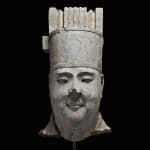Tang Large Stone Sculpture Depicting the Head of a Civic Official, 618 CE - 907 CE
Stone
83.8 x 39.4 cm
33 x 15 1/2 in
33 x 15 1/2 in
PF.5475
Further images
The Tang Dynasty was an era of unrivalled wealth and luxury. The country was successfully reunified and the borders were expanded, pushing Chinese influence into new lands. Confucianism became a...
The Tang Dynasty was an era of unrivalled wealth and luxury. The country was successfully reunified and the borders were expanded, pushing Chinese influence into new lands. Confucianism became a semi-religious instrument of the state; yet Buddhism continued to flourish, spreading into Korea and Japan. The arts reached new levels of sophistication. Poetry and literature flourished under the enlightened rulers. The Silk Road brought fortunes into China. Precious treasures were imported on the backs of camels from far away lands and bartered for Chinese silk, medicinal herbs, and pungent spices. Tang China was a multicultural empire where foreign merchants from across Central Asia and the Middle East settled in the urban centers, foremost among them the thriving capital of Chang’an (modern X’ian), a bustling cosmopolitan center of over two million inhabitants. Foreign traders lived next to native artisans and both thrived. New ideas and exotic artistic forms followed alongside. The Tang Dynasty was a cultural renaissance where many of the forms and objects we now associate with China were first created. Moreover, this period represents one of the greatest cultural outpourings in human history.
This large fragment of a head was once part of a much larger sculpture of a civic official. We can assume from the stature of this work that it likely stood outside as part of the spiritual road leading up to a mausoleum. Picture a procession of monumental civic officials, carved from stone, greeting the emperor as he makes his was inside. Such processional entranceways are well known in China and occur in the architecture of other cultures and civilizations such as the Ancient Egyptians. While it might seem odd to immortalize a government bureaucrat in stone, especially on such a grand scale, when we consider the importance of such civil officials in the daily life of the empire, their significance becomes clear. With over two million inhabitants in greater Chang’an, the cosmopolitan capital of the Tang, the governance of just this city alone would have demanded an extensive network of civic servants, not to mention the numerous distant provinces of that comprised the greater Empire. In order to remove power from the hands of wealthy aristocrats and warlords, the Tang created a class of scholar officials to govern their lands, enacting the will of the Imperial Court throughout China. Rigorous examinations ensured that only the most qualified individuals were able to serve this crucial position. The official wears a tall cap with a chinstrap that marks his status. Today, this monumental fragment is a stunning testament to the wealth and luxury of the Tang Dynasty, a golden age of Chinese culture made possible through the work of such officials.
This large fragment of a head was once part of a much larger sculpture of a civic official. We can assume from the stature of this work that it likely stood outside as part of the spiritual road leading up to a mausoleum. Picture a procession of monumental civic officials, carved from stone, greeting the emperor as he makes his was inside. Such processional entranceways are well known in China and occur in the architecture of other cultures and civilizations such as the Ancient Egyptians. While it might seem odd to immortalize a government bureaucrat in stone, especially on such a grand scale, when we consider the importance of such civil officials in the daily life of the empire, their significance becomes clear. With over two million inhabitants in greater Chang’an, the cosmopolitan capital of the Tang, the governance of just this city alone would have demanded an extensive network of civic servants, not to mention the numerous distant provinces of that comprised the greater Empire. In order to remove power from the hands of wealthy aristocrats and warlords, the Tang created a class of scholar officials to govern their lands, enacting the will of the Imperial Court throughout China. Rigorous examinations ensured that only the most qualified individuals were able to serve this crucial position. The official wears a tall cap with a chinstrap that marks his status. Today, this monumental fragment is a stunning testament to the wealth and luxury of the Tang Dynasty, a golden age of Chinese culture made possible through the work of such officials.
Literature
V26
11
of
11







